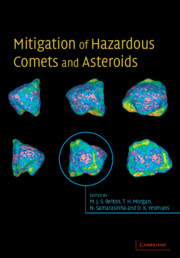Book contents
- Frontmatter
- Contents
- List of contributors
- Preface
- Acknowledgments
- Glossary
- 1 Recent progress in interpreting the nature of the near-Earth object population
- 2 Earth impactors: orbital characteristics and warning times
- 3 The role of radar in predicting and preventing asteroid and comet collisions with Earth
- 4 Interior structures for asteroids and cometary nuclei
- 5 What we know and don't know about surfaces of potentially hazardous small bodies
- 6 About deflecting asteroids and comets
- 7 Scientific requirements for understanding the near-Earth asteroid population
- 8 Physical properties of comets and asteroids inferred from fireball observations
- 9 Mitigation technologies and their requirements
- 10 Peering inside near-Earth objects with radio tomography
- 11 Seismological investigation of asteroid and comet interiors
- 12 Lander and penetrator science for near-Earth object mitigation studies
- 13 Optimal interception and deflection of Earth-approaching asteroids using low-thrust electric propulsion
- 14 Close proximity operations at small bodies: orbiting, hovering, and hopping
- 15 Mission operations in low-gravity regolith and dust
- 16 Impacts and the public: communicating the nature of the impact hazard
- 17 Towards a national program to remove the threat of hazardous NEOs
- Index
8 - Physical properties of comets and asteroids inferred from fireball observations
Published online by Cambridge University Press: 12 October 2009
- Frontmatter
- Contents
- List of contributors
- Preface
- Acknowledgments
- Glossary
- 1 Recent progress in interpreting the nature of the near-Earth object population
- 2 Earth impactors: orbital characteristics and warning times
- 3 The role of radar in predicting and preventing asteroid and comet collisions with Earth
- 4 Interior structures for asteroids and cometary nuclei
- 5 What we know and don't know about surfaces of potentially hazardous small bodies
- 6 About deflecting asteroids and comets
- 7 Scientific requirements for understanding the near-Earth asteroid population
- 8 Physical properties of comets and asteroids inferred from fireball observations
- 9 Mitigation technologies and their requirements
- 10 Peering inside near-Earth objects with radio tomography
- 11 Seismological investigation of asteroid and comet interiors
- 12 Lander and penetrator science for near-Earth object mitigation studies
- 13 Optimal interception and deflection of Earth-approaching asteroids using low-thrust electric propulsion
- 14 Close proximity operations at small bodies: orbiting, hovering, and hopping
- 15 Mission operations in low-gravity regolith and dust
- 16 Impacts and the public: communicating the nature of the impact hazard
- 17 Towards a national program to remove the threat of hazardous NEOs
- Index
Summary
Introduction
Understanding the inventory and size distribution of those bodies which during their orbital evolution can intersect the orbit of the Earth with a non-zero probability of collision is a high priority task for modern planetary science. Apart from obvious considerations about mitigation of the impact hazard for the terrestrial biosphere, this is also a challenging theoretical problem, with important implications for our understanding of the orbital and physical evolution of the minor bodies of our solar system.
Several mechanisms have been discovered and analyzed in recent years to explain the steady influx of bodies from different regions of the solar system to the zone of the terrestrial planets. Several unstable regions in the orbital element space have been identified in the asteroid main belt, which can lead bodies to be decoupled from the belt and evolve into near-Earth object (NEO) orbits (Morbidelli et al. 2002). Both conventional collisional mechanisms and dynamical non-gravitational mechanisms (Yarkovsky effect) can be responsible for a steady injection of main-belt asteroids into these unstable orbits. Even in the absence of unstable regions, the Yarkovsky effect can cause a continuous drift in semimajor axis and eccentricity, eventually leading to a close encounter with a terrestrial planet, and removal from the main asteroid belt (Spitale and Greenberg 2001, 2002). The NEO production rate and the resulting NEO inventory and size distributions can be theoretically estimated and compared with observations (Bottke et al. 2002). It should be noted that the effectiveness of the different supply mechanisms is eminently size dependent.
Information
- Type
- Chapter
- Information
- Mitigation of Hazardous Comets and Asteroids , pp. 153 - 166Publisher: Cambridge University PressPrint publication year: 2004
Accessibility standard: Unknown
Why this information is here
This section outlines the accessibility features of this content - including support for screen readers, full keyboard navigation and high-contrast display options. This may not be relevant for you.Accessibility Information
- 5
- Cited by
